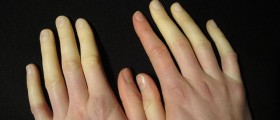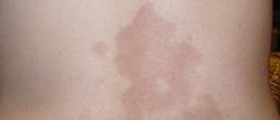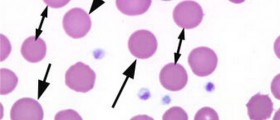
Variegate porphyria is a type of porphyria inherited in an autosomal dominant fashion. The condition is also known under the names mixed hepatic porphyria, mixed porphyria and South African genetic porphyria. Variegate porphyria is a condition with acute symptoms some of which affect the skin. All clinical characteristics of the disease develop as a consequence of low levels of the enzyme necessary for the seventh step in heme production. So, people suffering from variegate porphyria are not capable of producing heme, a vital molecule which is a part of hemoglobin, the protein essential for transfer of oxygen in the blood.
Variegate Porphyria Clinical Characteristics
It is possible that certain number of patients never develop symptoms or signs of variegate porphyria. In them the disease is practically asymptomatic. However, if the symptoms develop they occur suddenly in a form of an acute attack. This is quite similar to acute intermittent porphyria.
The first attack is most commonly reported in adulthood. Patients complain about abdominal pain, vomiting diarrhea and/or constipation. The attack is also characterized by muscle weakness, seizures and mental changes (e.g. anxiety, hallucinations etc). There are different triggers of the attacks. Some of them are dieting, fasting, stress, imbalance of certain hormones and intake of some medications.
It is possible for some patients to experience severe skin changes because their skin is way too sensitive to sunlight. In such individuals after sun exposure the skin gets covered with blisters, there are changes in pigmentation and later scarring. Cases of increased hair growth have also been reported. The skin which has been exposed becomes fragile and susceptible to further damage.
Pathophysiology and Epidemiology
In people suffering from variegate porphyria porphyrins (protoporphyrin and coproporphyrin) accumulate in the body because of inadequate heme synthesis. There is also increase in the porphyrin precursors (porphobilinogen and aminolevulinic acid). These are abundant during the episodic attacks and are responsible for all dysfunctions of central, autonomic and peripheral nervous system.
In South Africa the condition affects around 1 out of 300 individuals. In Finland, on the other hand, the incidence is 1 in 75,000. The condition is also reported in Switzerland, Argentina and Sweden.
An autosomal dominant pattern is a way of transmission of the disease. This is why the condition develops easily once a person inherits one copy of the defective gene from an affected parent. In case the person inherits two copies from both parents, symptoms and sign become more severe and harder to deal with.
There is no specific treatment for variegate porphyria. The goal of the treatment is to bring all the symptoms under control the treatment is symptomatic. And finally, it is essential to avoid all the potential triggers of the attacks such as certain drugs and exposure to some chemicals.









-and-Multiple-Sclerosis-Differences-And-Similarities_f_280x120.jpg)







Your thoughts on this
Loading...